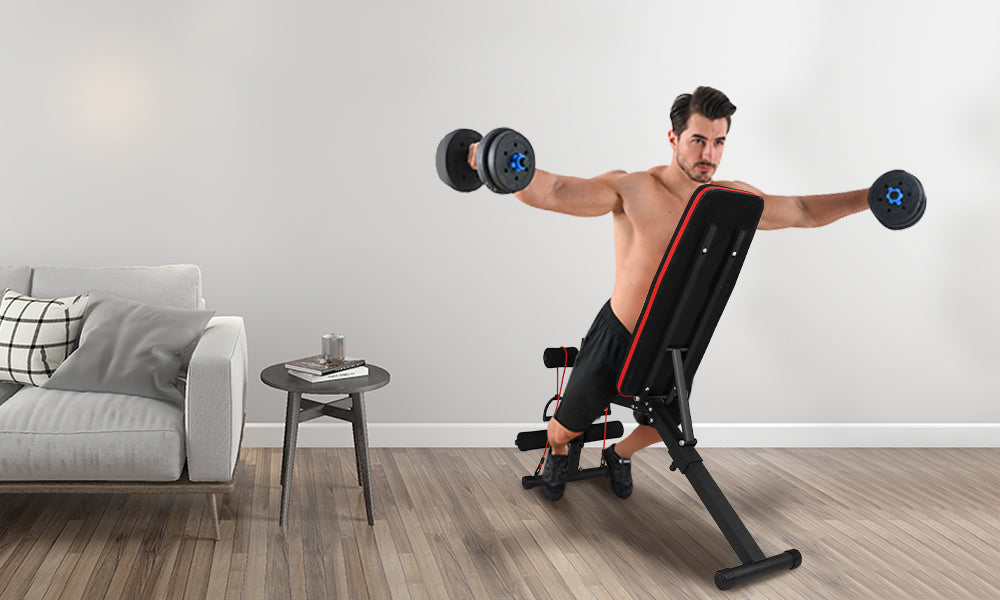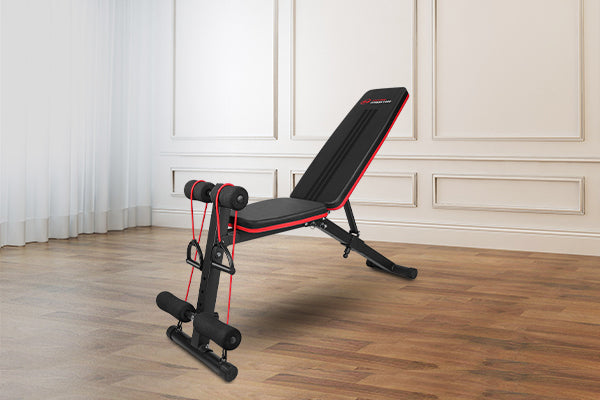To use a workout bench, adjust it to the desired angle and perform your exercises with proper form. Ensure your back and feet are stable.
A workout bench is a versatile piece of gym equipment. It allows you to perform various exercises targeting different muscle groups. From chest presses to leg raises, the bench can enhance your fitness routine. Adjust the bench to flat, incline, or decline positions to diversify your workouts.
It’s essential to maintain proper form to avoid injuries. Position your feet firmly on the ground and keep your back supported. This setup provides stability and maximizes the effectiveness of each exercise. Using a workout bench correctly can significantly improve your strength and overall fitness.

Credit: www.pinterest.com
Introduction To Workout Benches
Workout benches are essential for any fitness routine. They offer support and stability during exercises. This guide will help you understand their uses and benefits.
The Versatility Of A Workout Bench
A workout bench can adapt to many exercises. It supports strength training, core workouts, and flexibility exercises.
- Strength Training: Use the bench for bench presses and dumbbell exercises.
- Core Workouts: Perform sit-ups, leg raises, and Russian twists.
- Flexibility: Stretch your muscles using the bench for support.
Its adjustable feature allows for various incline and decline positions. This versatility helps target different muscle groups effectively.
Key Benefits For Fitness Enthusiasts
Using a workout bench offers numerous benefits for fitness enthusiasts. Here are some key advantages:
| Benefit | Description |
|---|---|
| Enhanced Stability | The bench provides a stable platform for exercises. |
| Increased Range of Motion | Allows for deeper movements, improving muscle engagement. |
| Versatile Use | Supports a variety of exercises for a full-body workout. |
| Adjustable Positions | Incline and decline settings target different muscle groups. |
These benefits make workout benches a valuable addition to any home gym. They enhance your workout experience and results.
Types Of Workout Benches
Workout benches are essential for various exercises. They offer support and flexibility. Choosing the right bench can enhance your workout routine. Let’s explore the different types of workout benches.
Flat Benches For Basic Exercises
Flat benches are simple and sturdy. They are perfect for beginners. You can use them for basic exercises like:
- Bench Press
- Tricep Dips
- Seated Shoulder Press
Flat benches provide a stable surface. They are great for building foundational strength. They are often cheaper than other types of benches.
Adjustable Benches For Versatile Workouts
Adjustable benches offer flexibility. You can change the incline or decline. This makes them ideal for a range of exercises, such as:
- Incline Bench Press
- Decline Sit-Ups
- Flat Bench Exercises
Adjustable benches allow you to target different muscle groups. They are perfect for diverse workout routines. Their versatility makes them a popular choice among fitness enthusiasts.
Specialty Benches For Targeted Training
Specialty benches are designed for specific exercises. They help target particular muscle groups. Some common specialty benches include:
| Bench Type | Targeted Exercise |
|---|---|
| Ab Bench | Abdominal Exercises |
| Preacher Curl Bench | Bicep Curls |
| Hyperextension Bench | Lower Back Exercises |
Specialty benches are great for focused training. They are often used by advanced lifters. Each type serves a unique purpose in your workout regimen.
Selecting The Right Bench
Choosing the right workout bench is crucial for your fitness goals. A good bench improves your workout efficiency and safety. Let’s explore key points to consider.
Factors To Consider Before Purchase
- Purpose: Identify your workout needs and goals.
- Adjustability: Ensure the bench has multiple incline and decline settings.
- Weight Capacity: Check the maximum weight the bench can hold.
- Space: Measure the area where you’ll place the bench.
- Budget: Determine how much you are willing to spend.
Safety And Comfort Features
A workout bench should be safe and comfortable. Look for the following features:
| Feature | Importance |
|---|---|
| Padding: | Thick padding ensures comfort during workouts. |
| Stability: | Non-slip feet keep the bench stable. |
| Build Quality: | Strong materials make the bench durable. |
| Safety Locks: | Locks secure the bench in position. |
Pay attention to these features to ensure a safe and effective workout.
Setting Up Your Workout Space
Creating an effective workout space is crucial for achieving fitness goals. A well-organized area can enhance your exercise routine and ensure safety. Below, we guide you through setting up your workout space with a focus on using a workout bench.
Ideal Placement For Your Bench
Place your bench in a well-lit area to improve visibility. Ensure there is enough space around the bench for movement. Keep a distance of at least 3 feet on all sides. This allows for a range of exercises and prevents accidents.
Position the bench on a non-slip surface. This provides stability during workouts. If indoors, avoid placing the bench near fragile items or furniture. Outdoors, consider a shaded spot to avoid sun exposure.
Essential Accessories For An Effective Workout
Having the right accessories enhances your workout experience. Here are some essential items:
- Dumbbells: Versatile for various exercises.
- Resistance Bands: Great for strength training.
- Yoga Mat: Provides comfort for floor exercises.
- Water Bottle: Stay hydrated during workouts.
- Towel: Keep sweat in check.
Consider investing in a small storage unit. This keeps accessories organized and accessible. A clutter-free space improves focus and efficiency.
| Accessory | Purpose |
|---|---|
| Dumbbells | Weight training |
| Resistance Bands | Strength training |
| Yoga Mat | Comfort for floor exercises |
| Water Bottle | Hydration |
| Towel | Sweat management |
Set up your workout space thoughtfully. This ensures a productive and safe exercise environment.
Basic Exercises To Get Started
Starting a workout routine can be exciting. A workout bench is a versatile tool. It helps you perform a variety of exercises. Here are some basic exercises to get started.
Bench Press Variations
The bench press is a classic exercise. It helps build chest, shoulder, and tricep muscles. Here are some variations:
- Flat Bench Press: Lie flat and press the barbell up.
- Incline Bench Press: Set the bench to an incline. This targets the upper chest.
- Decline Bench Press: Set the bench to a decline. This targets the lower chest.
Start with a weight you can handle easily. Increase the weight gradually as you gain strength.
Tricep Dips And Leg Raises
Tricep dips and leg raises are effective exercises. They target your triceps and core muscles.
- Tricep Dips:
- Place your hands on the bench edge.
- Lower your body until your arms are at a 90-degree angle.
- Push back up to the starting position.
- Leg Raises:
- Lie flat on the bench.
- Lift your legs until they are perpendicular to the bench.
- Lower them back down without touching the bench.
Perform these exercises in sets of 10-15 reps.
Step-ups And Plyometric Moves
Step-ups and plyometric moves are great for cardio. They also build leg strength.
- Step-Ups:
- Stand in front of the bench.
- Step up with your right foot.
- Bring your left foot up to meet the right.
- Step back down with your right foot first.
- Plyometric Moves:
- Bench Jumps: Jump onto the bench and step back down.
- Box Jumps: Similar to bench jumps but on a higher platform.
These exercises improve your agility and cardiovascular fitness.

Credit: www.homefitnesscode.com
Advanced Techniques For Muscle Growth
Using a workout bench can boost your muscle growth. Advanced techniques take your workout to the next level. These methods target different muscle groups and increase intensity. Here are some effective techniques to maximize your gains.
Incline And Decline Workouts
Incline and decline workouts change the angle of your bench. This helps in targeting specific muscles.
- Incline Bench Press: Set the bench at a 45-degree angle. This targets the upper chest and shoulders.
- Decline Bench Press: Set the bench at a negative 30-degree angle. This works the lower chest muscles.
Combining Weights For Increased Intensity
Combining weights can make your workouts more challenging. Mix different weights for better results.
| Exercise | Weights |
|---|---|
| Bench Press | Barbell and Dumbbells |
| Leg Raises | Ankle Weights and Medicine Ball |
Supersets And Dropsets
Supersets and dropsets add intensity to your workout. These techniques involve performing exercises back-to-back.
- Supersets: Perform two exercises consecutively without rest. For example, bench press followed by push-ups.
- Dropsets: Start with a heavy weight. Once tired, reduce the weight and continue the exercise.
These methods can speed up muscle growth and save time.
Incorporating Bodyweight Routines
A workout bench is a versatile tool. It can enhance many bodyweight exercises. By using the bench, you can increase the intensity of your workouts. This section will show how to incorporate bodyweight routines effectively.
Leveraging The Bench For Calisthenics
Calisthenics exercises use your body weight for resistance. A workout bench adds variety and challenge to these exercises. Here are some great calisthenics moves you can do:
- Bench Dips: Sit on the bench edge. Place hands on the bench. Slide off and dip your body down, then push up.
- Incline Push-ups: Place hands on the bench. Keep your body straight. Lower your chest to the bench, then push back up.
- Decline Push-ups: Place feet on the bench. Hands on the floor. Lower your chest to the floor, then push back up.
Core Strengthening Exercises
A strong core is essential for overall fitness. The workout bench is great for targeting your core muscles. Here are some exercises that focus on core strength:
- Bench Leg Raises: Lie on the bench. Hold the bench behind your head. Lift your legs up to a 90-degree angle, then lower them slowly.
- Bench Planks: Place your forearms on the bench. Keep your body straight. Hold this position for as long as possible.
- Russian Twists: Sit on the bench. Lean back slightly. Twist your torso from side to side, touching the bench with your hands.
| Exercise | Muscle Group | Reps |
|---|---|---|
| Bench Dips | Triceps | 10-15 |
| Incline Push-ups | Chest | 10-15 |
| Decline Push-ups | Chest | 10-15 |
| Bench Leg Raises | Abs | 10-15 |
| Bench Planks | Core | Hold for 30-60 secs |
| Russian Twists | Obliques | 20-30 |
Safety Tips And Injury Prevention
Working out on a bench can boost your strength. But, it is crucial to stay safe. Injuries can happen if you use the bench wrong. Follow these tips to stay injury-free and get the best results.
Proper Form And Posture
Maintaining proper form and posture is key to avoiding injuries. Always keep your back straight. Your feet should be flat on the ground. Do not arch your back. Keep your head in a neutral position. Make sure your shoulders are not hunched.
Here are a few tips for common exercises:
- Bench Press: Keep your wrists straight. Lower the bar to your chest, not your neck.
- Shoulder Press: Keep your elbows slightly bent. Do not lock them out.
- Leg Raises: Keep your lower back pressed into the bench. Do not let it arch.
Warm-up And Cool-down Importance
A proper warm-up and cool-down is crucial. Warming up prepares your muscles for the workout. Cooling down helps your body recover.
Follow these steps:
- Warm-Up: Do 5-10 minutes of light cardio. Follow with dynamic stretches.
- Cool-Down: After your workout, do 5-10 minutes of light cardio. Finish with static stretches.
When To Increase Weights And Resistance
Knowing when to increase weights and resistance is vital. Do not rush to lift heavier weights. Increase weights only when you feel ready.
Consider these guidelines:
| Condition | Action |
|---|---|
| Can complete all sets easily | Increase weight by 5-10% |
| Struggling to complete sets | Stay at current weight |
| Experiencing pain | Reduce weight or rest |
Always listen to your body. If you feel pain, stop immediately.
Creating A Balanced Workout Plan
Creating a balanced workout plan using a workout bench can be rewarding. It helps in targeting different muscle groups effectively. A well-structured plan ensures you get the best results while avoiding injury.
Integrating Bench Workouts Into Your Regimen
Integrate bench workouts into your regimen to enhance your routine. A workout bench offers versatility. You can perform various exercises like bench presses, dumbbell rows, and step-ups. Follow these steps for integration:
- Identify your goals: Determine if you want to build strength, endurance, or flexibility.
- Select exercises: Choose exercises that target different muscle groups.
- Plan your schedule: Allocate specific days for bench workouts.
Frequency And Duration For Optimal Results
Frequency and duration are crucial for optimal results. Too much or too little can impact your progress. Follow these guidelines:
| Goal | Frequency | Duration |
|---|---|---|
| Strength | 3-4 days per week | 45-60 minutes per session |
| Endurance | 2-3 days per week | 30-45 minutes per session |
| Flexibility | 1-2 days per week | 20-30 minutes per session |
Balance your workouts with proper rest. This prevents fatigue and injury. Listen to your body. Adjust your plan as needed.
Tracking Progress And Staying Motivated
Using a workout bench is great for building strength. But tracking progress and staying motivated is key for long-term success. With clear goals and regular monitoring, you can stay on track. Let’s dive into how to keep motivated and track your gains.
Setting Achievable Goals
Start by setting achievable goals. These goals should be clear and realistic. Here are some tips for setting goals:
- Define what you want to achieve, like lifting more weight.
- Break down big goals into smaller, manageable steps.
- Set a timeline to reach each goal.
- Write down your goals to stay committed.
For example, if you want to bench press 100 lbs, start with smaller weights. Gradually increase the weight each week. This approach helps you see progress without getting overwhelmed.
Monitoring Improvements And Adjusting Routines
Once you have set your goals, it’s time to track your progress. Monitoring improvements helps you see how far you’ve come. It also helps in adjusting routines for better results. Here’s how to do it:
| Aspect | How to Track | Adjustments |
|---|---|---|
| Weight Lifted | Record the weight in a journal | Increase weight gradually |
| Reps and Sets | Note the number of reps and sets | Add more reps or sets over time |
| Form and Technique | Check your form using a mirror | Focus on improving technique |
Use a workout journal or app to keep track. This helps in seeing patterns and making necessary changes. If you notice you’re not progressing, change your routine. Try new exercises or increase intensity. Keep your workouts fresh and challenging.
Staying motivated can be challenging. Celebrate small victories to keep your spirits high. Reward yourself when you hit a milestone. Remember, progress takes time and effort.

Credit: www.ritfitsports.com
Frequently Asked Questions
How Do You Properly Use A Workout Bench?
To properly use a workout bench, adjust it to your required angle. Ensure stability. Perform exercises with controlled movements to avoid injury.
What Exercises Can You Do On A Workout Bench?
You can perform bench presses, dumbbell flies, tricep dips, and step-ups. These exercises target various muscle groups.
How Do You Adjust A Workout Bench?
Adjust the bench by pulling the pin or lever. Set it to the desired angle. Ensure it’s securely locked.
Why Use A Workout Bench For Home Workouts?
Using a workout bench enhances exercise variety. It offers stability and proper support. It’s ideal for strength training at home.
Conclusion
Mastering the use of a workout bench can elevate your fitness routine. It offers versatility and enhances strength training. Always maintain proper form to avoid injuries. Incorporate these tips into your workouts for better results. Consistent practice will lead to significant improvements in your overall fitness and health.




Leave a Reply